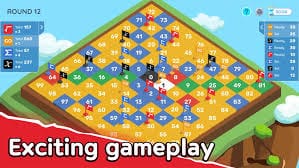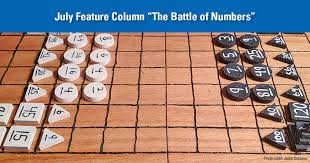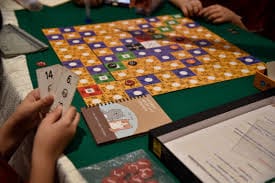Battle of the Numbers
Battle of the Numbers, a dynamic and educational card game by Concent Edu, Inc., transforms arithmetic into an engaging, competitive experience. Designed for players aged 9 and up, this strategy game blends math skills, quick thinking, and tactical decision-making, making it a favorite in classrooms, homes, and even competitive settings. Available as both a physical board game and a digital app, it challenges players to combine number cards to hit target numbers while outsmarting opponents. This article explores the game’s origins, mechanics, appeal, educational benefits, and cultural impact, revealing why it’s a standout in math-based gaming.

Origins and Development
Battle of the Numbers was created by Concent Edu, Inc., a South Korean company founded to make math education fun through board games. Launched as a physical game and later adapted for iOS and Android, it reflects a mission to foster natural learning in math and science. The game draws inspiration from classic number games like dominoes or rummy, where players manipulate numbers to achieve specific goals, but it introduces a competitive twist with strategic card play. Since its release, it has gained traction for its accessibility and depth, with updates enhancing its digital version for smoother gameplay. Its focus on arithmetic operations and logical thinking aligns with educational curricula, making it a go-to resource for teachers and parents.
The game’s development emphasizes fun learning, aiming to make math approachable for children and adults alike. By integrating strategy and competition, it transforms abstract concepts into tangible challenges, earning praise on platforms like Amazon and Google Play for its innovative approach. Its contest mode, likened to chess tournaments, hints at its potential for organized play, further cementing its cultural footprint.
Gameplay Mechanics
Battle of the Numbers is a strategy game for 2–4 players, using a deck of 49 number cards (0–9), a game board, a sandglass, and markers. The core objective is to combine three number cards using addition to form multiples of 10 (e.g., 10, 20, 30, up to 90) that match a target number between 0 and 99. The game blends speed, strategy, and mathematical precision, with players racing to claim numbers before opponents.
- Setup: Each player receives a set of number cards, and a target number is revealed (e.g., 40). The game board tracks claimed numbers, and the sandglass (in physical versions) adds a time attack element for faster rounds.
- Gameplay: Players select three cards to add up to a multiple of 10 closest to the target. For example, to hit 40, a player might use 7, 8, and 5 (7 + 8 + 5 = 20) or aim higher with 9, 8, and 3 (9 + 8 + 3 = 20). The first to register their combination claims the number, but opponents can challenge by forming the same number to steal it. Each round introduces a new target, keeping the pace dynamic.
- Special Functions: Numbers have unique powers. A multiple of 2 can be deleted with a 2 card, while a 0 card can erase multiples of 3. Prime numbers are safer, as they resist most attacks, adding a layer of tactical depth. Players must decide whether to secure a number by claiming it twice (using two turns) or risk losing it to focus on new targets.
- Winning: The game ends after a set number of rounds or when a player claims the most target numbers. In contest mode, players aim for high scores based on strategic number captures. The sandglass ensures quick decisions, enhancing the competitive thrill.
The digital version, available on the App Store and Google Play, streamlines setup and adds solo play against AI, with updates improving performance and fixing bugs. The physical game, detailed on Amazon, includes a 15–40-minute playtime, making it versatile for quick or extended sessions.
Why It Captivates
Battle of the Numbers shines for its blend of accessibility and complexity. The rules are simple—combine three cards to hit a multiple of 10—yet the strategic choices (e.g., saving high-value cards or using a 0 to disrupt opponents) keep players engaged. The time attack mechanic, especially with the sandglass, adds adrenaline, making it ideal for lively group play. Its replayability stems from varied target numbers and card combinations, ensuring no two games are identical.
The game appeals to both children and adults. Kids enjoy the math challenge, while adults appreciate the tactical depth, such as deciding whether to secure a number or pursue a new one. Its compact components (49 cards, a small board) make it portable, perfect for travel or classroom use. Digital versions enhance accessibility, running smoothly on modest devices and offering solo play for practice.
Educational Benefits
Battle of the Numbers is a powerhouse for math education. It reinforces addition, number sense, and pattern recognition, aligning with curricula for ages 9+. Players practice forming multiples and working with prime numbers, building fluency in mental math. The time attack mode sharpens quick calculation, while special card functions teach number properties (e.g., divisibility).
The game fosters critical thinking and strategic planning. Players must weigh risks—should they use a 0 to delete an opponent’s number or save it for a higher-value target? This decision-making mirrors real-world problem-solving. In classrooms, teachers use it to engage students in arithmetic practice, while parents value its screen-free nature. Reviews on Google Play highlight children’s intense focus and ability to create formulas independently, a testament to its educational impact.
Socially, the game promotes teamwork and sportsmanship. Players learn to handle competition gracefully, whether celebrating a clever move or recovering from a lost number. Its contest mode encourages logical thinking, making it a potential staple in math clubs or tournaments.
Cultural Impact and Community
Battle of the Numbers has carved a niche in educational gaming. Online communities, particularly on educational platforms, share strategies and praise its ability to make math fun. Amazon reviews note its appeal for family game nights, with parents surprised by kids’ engagement. The game’s contest mode, likened to chess, suggests potential for organized play, with Concent Edu hosting events to promote math literacy.

Its digital presence on iOS and Android has broadened its reach, with updates ensuring compatibility and user satisfaction. Posts on X and educational forums highlight its role in making math accessible, especially for reluctant learners. The game’s South Korean origins add a global flair, with its design reflecting a universal appeal.
Conclusion
Battle of the Numbers is a brilliant fusion of math, strategy, and fun. Its simple yet deep mechanics, educational value, and competitive edge make it a standout for players of all ages. Whether played on a game board with friends or solo on a phone, it transforms arithmetic into an adventure. As Concent Edu continues to innovate, this game proves that numbers can spark excitement, learning, and connection, one clever combination.
